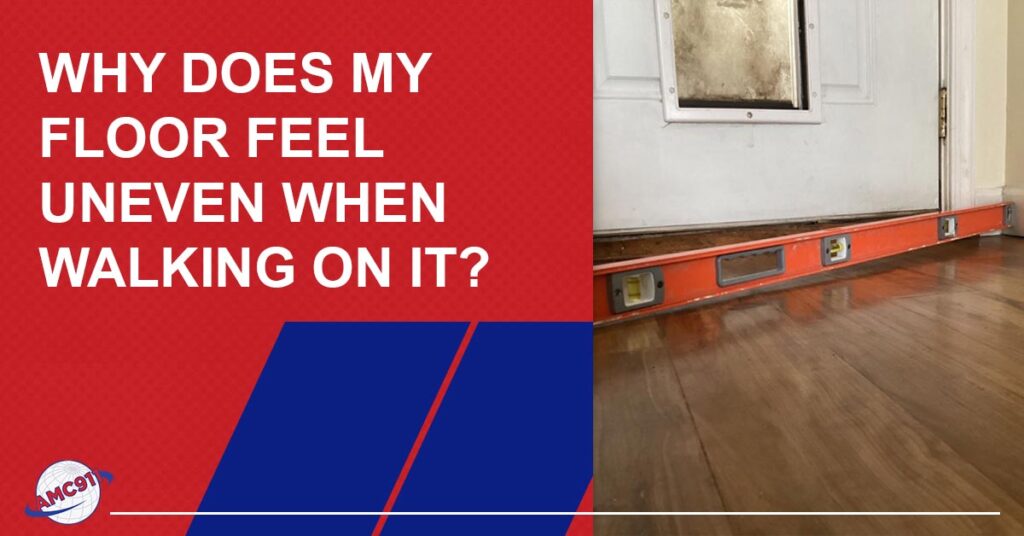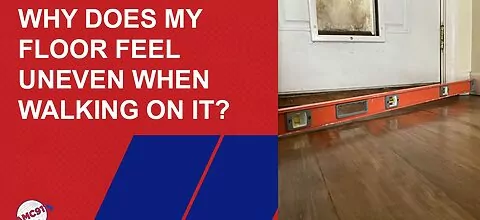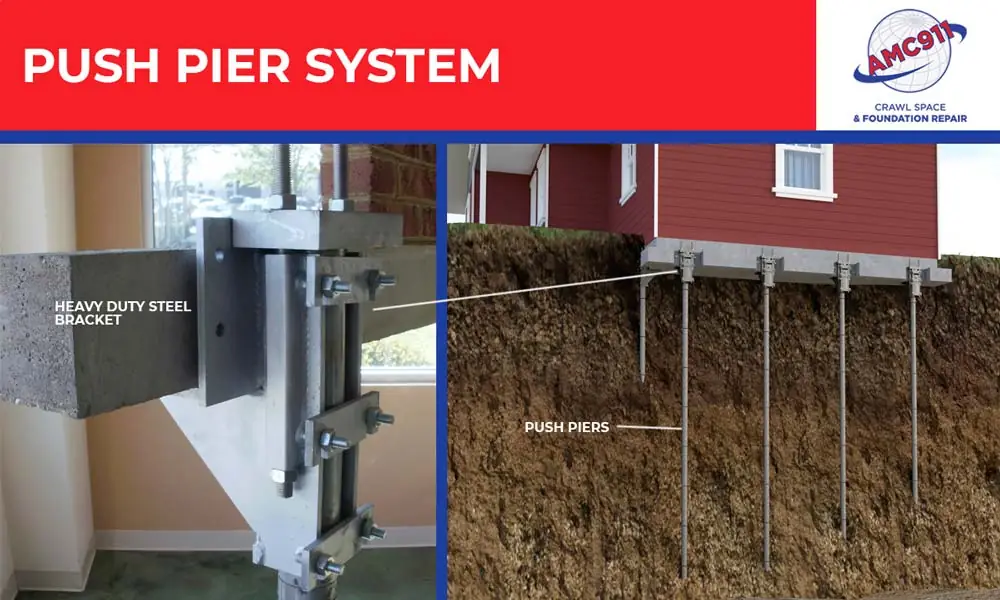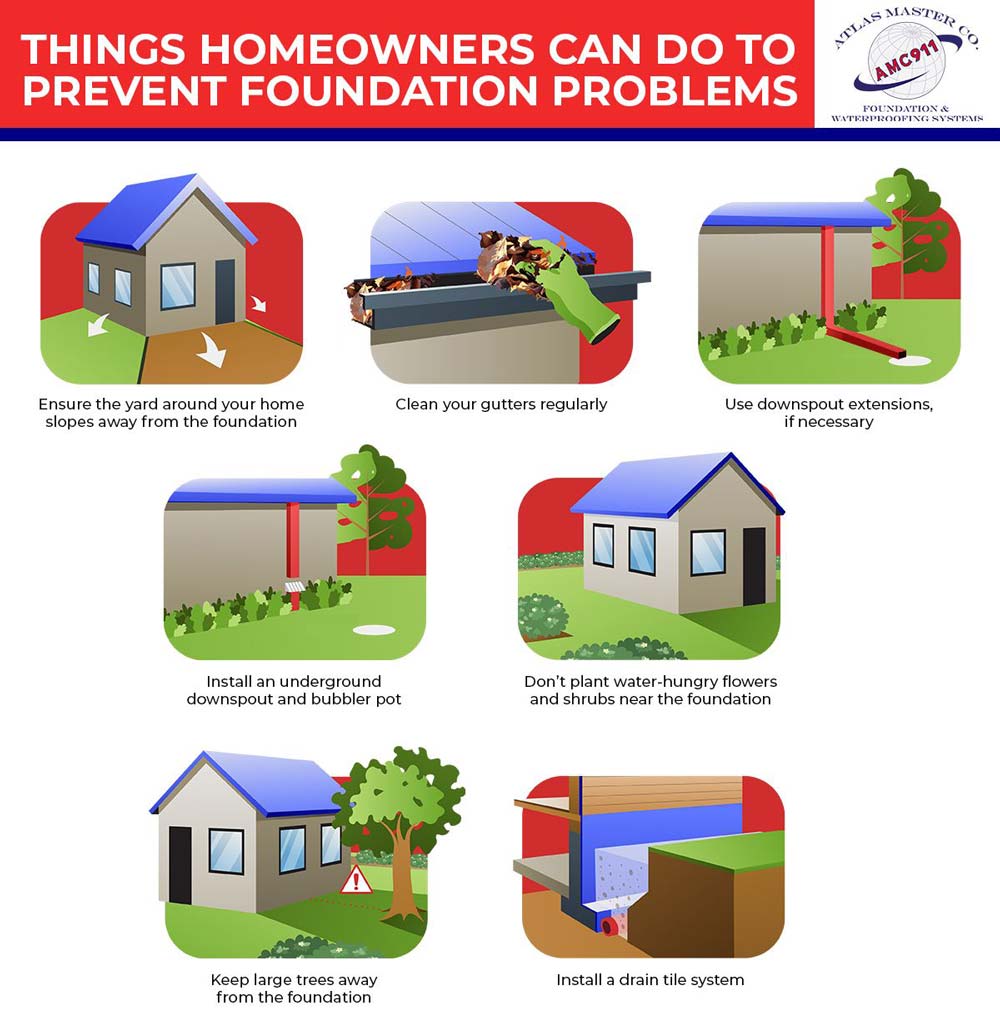Wondering why your floor feels uneven when you walk on it? If so, don’t hit that back button because you’ve landed on the right page. In this article, we’re going to go over the two leading causes of uneven floors, what’s the first thing you need to do after you notice an uneven floor, repair solutions for uneven floors, and more.
What Causes Uneven Floors?
While many factors can contribute to uneven floors, the most common causes are differential settlement and issues with the crawl space, such as settled support posts. Let’s take a look at both:
How differential settlement can cause uneven floors
All structures settle into the ground a tiny amount after construction. Usually this settlement is uniform. That is, the entire foundation is settling at the same rate. Problems arise when a foundation experiences differential(i.e., uneven) settlement. The best way to describe differential settlement is through an illustration:
So, what causes differential settlement?
Various things can cause a foundation to settle unevenly into the ground. These include the following:
- Poor construction practices – When soil isn’t adequately compacted before construction, tiny air pockets remain and, over time, these will compress from the weight of the structure. This could lead to differential settlement.
- Expansive soil – Soil that contains a high percentage of clay is called “expansive” because it swells when it soaks up moisture and then shrinks when it dries out. This swelling and shrinking – usually seasonal – creates movement in the ground under the foundation and can lead to differential settlement.
- Erosion-prone soil – Some soil types are prone to erosion. This, along with poor drainage around the house, can lead to the formation of voids under the foundation. If the foundation settles into the voids, differential settlement will happen.
- Natural disasters – Earthquakes, floods, hurricanes, tornados, etc., can all cause differential settlement.
- Excavation – If your neighbor digs a big hole too close to your house, it could destabilize the soil under the foundation, leading to differential settlement.
How problems in the crawl space can cause uneven floors
Problems in the crawl space are another common cause of uneven floors. The problem is often caused by support posts that have settled into the ground and are no longer vertical or by screw jacks that have deteriorated. Both problems could be related to moisture in the crawl space. The ground might be soggy because of poor drainage around the foundation, for example, and this has caused the support posts to settle. Excess moisture in a crawl space can also cause screw jacks to deteriorate. Other causes of uneven floors over a crawl space include an inadequate number of support posts, beams or joists and rotten support posts.
For more information, see Do You Need A Vapor Barrier In Your Crawl Space?
It’s important to note that we’re not talking about things like wood floors that have become warped and uneven from water damage. These types of problems are with the floor itself, not with the house’s foundation.
If You Have An Uneven Floor, Look Around For Other Problems
If you have an uneven floor in your home, look around for other indications of a foundation problem. Here are some things to look for:
- Cracks in walls, floors, and ceilings
- Windows and doors that no longer open and close properly
- Musty smell (This could indicate a problem with mold in the crawl space caused by excess moisture.)
- Stair step cracks in brick or masonry
- Chimneys or porches that are pulling away from the house
- Separations between the walls and the ceilings or floors
- Torn or wrinkled wallpaper (The wall behind the wallpaper might be cracked.)
If you notice any of the above in addition to the uneven floor, contact a foundation repair contractor right away and ask for a foundation evaluation. Don’t delay because foundation problems only worsen, and if you wait, you’ll end up paying more for the repair.
How Are Uneven Floors Fixed?
The chosen repair solution for an uneven floor will depend on what caused it. The solution for an uneven floor caused by differential settlement will be different from the solution for an uneven floor caused by problems in a crawl space.
Repairing uneven floors caused by differential settlement
If the uneven floor was caused by differential settlement, the solution will be to underpin the foundation using piers. These might be push piers, helical piers, slab piers, or drilled concrete piers. Underpinning a foundation means extending the foundation down to load-bearing soil or bedrock. The general installation procedure for push piers is as follows:
- The soil around the foundation is excavated down to the footing.
- Heavy duty steel brackets are attached to the footing.
- The push piers are then driven into the ground through the brackets until they reach load-bearing soil.
- Once the piers are in place, a synchronized hydraulic lifting system raises the house to maximum practical level. This is an industry term that means the structure is raised as much as possible without causing damage.
Repairing uneven floors caused by problems in the crawl space
If the uneven floor was caused by settled support posts or deteriorated screw jacks, the solution will be to replace the support posts or screw jacks. However, unless the root cause of the problem is addressed, you’ll be facing the same issue again eventually. For example, if the problem was caused by poor drainage around the foundation, installing a drain tile system might be necessary in addition to the crawl space repair.
How To Help Prevent Foundation Problems
Many homeowners are surprised to learn that most foundation problems are caused by excess moisture in the ground around the foundation. Therefore, you can help prevent foundation issues by controlling groundwater around the foundation. Here are some ways to do that:
- Clean your gutters regularly – One of the simplest yet most effective ways to prevent foundation problems is to simply clean your gutters regularly. Clogged gutters can cause water to spill over the side of the house and soak into the ground around the foundation where it can cause problems.
- Install downspout extensions – Downspout extensions offer an additional layer of protection against water damage by directing rainwater away from the foundation before release.
- Regrade your yard, if necessary – Regrading your yard can also be a beneficial step in preventing foundation problems. Ideally, your yard should slope away from the house, allowing water to flow freely away from the foundation. Consider hiring a professional landscaper to assess your yard’s grading and make any necessary adjustments.
- Consider relocating vegetation – You might want to consider relocating any water-hungry flowers or shrubs planted next to the house. You don’t want to give yourself a reason to add additional moisture to the ground around the foundation.
- Install a drain tile system – When it comes to foundation waterproofing, a drain tile system is a gold standard. A drain tile system isn’t about putting up a barrier to keep water out, it’s about preventing excess moisture from building up in the ground around the foundation in the first place. A drain tile system collects any excess water and channels it away from your home, reducing the risk of water damage and foundation issues. The general installation process is as follows:
- The soil around the perimeter of the foundation is excavated down to the footing.
- A shallow trench is dug around the perimeter of the foundation and then lined with gravel.
- A perforated drainage pipe is placed on top of the gravel and covered with more gravel.
- Finally, the excavated soil is replaced along with any landscaping that was removed.
Now, excess moisture in the soil will flow into the drainage pipe via the holes and toward a sump pit. When the sump pit fills with water, a sump pump turns on and ejects the way a safe distance from the foundation.
Taking the above preventative measures can help safeguard your home’s foundation against problems.
If you’re concerned about a floor in your home that feels uneven when you’re walking on it, contact AMC911 today to schedule a foundation evaluation. If we find a problem, we’ll give you a repair estimate.





















